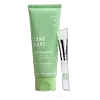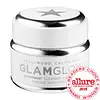What's inside
What's inside
 Key Ingredients
Key Ingredients

 Benefits
Benefits

 Concerns
Concerns

 Ingredients Side-by-side
Ingredients Side-by-side

Water
Skin ConditioningKaolin
AbrasiveMagnesium Aluminum Silicate
AbsorbentGlycerin
HumectantPropanediol
SolventButylene Glycol
HumectantFomes Officinalis Extract
Skin ProtectingMicrocrystalline Cellulose
AbsorbentSalicylic Acid
MaskingPhenoxyethanol
PreservativePolyacrylate Crosspolymer-6
Emulsion StabilisingDecyl Glucoside
CleansingNiacinamide
SmoothingAloe Barbadensis Leaf Juice
Skin ConditioningSodium Hydroxide
BufferingCellulose Gum
Emulsion StabilisingCI 77288
Cosmetic ColorantMaltodextrin
AbsorbentBixa Orellana Seed Extract
MaskingEthylhexylglycerin
Skin ConditioningTetrasodium Glutamate Diacetate
Citric Acid
BufferingInulin
Skin ConditioningZinc Oxide
Cosmetic ColorantTasmannia Lanceolata Fruit/Leaf Extract
AntioxidantCentipeda Cunninghamii Extract
Skin ConditioningCitrus Australasica Fruit Extract
AntioxidantAlpha-Glucan Oligosaccharide
CleansingSalix Alba Bark Extract
AstringentPEG-40 Hydrogenated Castor Oil
EmulsifyingHamamelis Virginiana Leaf Extract
Skin ConditioningSodium Benzoate
MaskingPotassium Sorbate
PreservativeWater, Kaolin, Magnesium Aluminum Silicate, Glycerin, Propanediol, Butylene Glycol, Fomes Officinalis Extract, Microcrystalline Cellulose, Salicylic Acid, Phenoxyethanol, Polyacrylate Crosspolymer-6, Decyl Glucoside, Niacinamide, Aloe Barbadensis Leaf Juice, Sodium Hydroxide, Cellulose Gum, CI 77288, Maltodextrin, Bixa Orellana Seed Extract, Ethylhexylglycerin, Tetrasodium Glutamate Diacetate, Citric Acid, Inulin, Zinc Oxide, Tasmannia Lanceolata Fruit/Leaf Extract, Centipeda Cunninghamii Extract, Citrus Australasica Fruit Extract, Alpha-Glucan Oligosaccharide, Salix Alba Bark Extract, PEG-40 Hydrogenated Castor Oil, Hamamelis Virginiana Leaf Extract, Sodium Benzoate, Potassium Sorbate
Water
Skin ConditioningKaolin
AbrasiveMagnesium Aluminum Silicate
AbsorbentMandelic Acid
AntimicrobialCarbon
Eucalyptus Globulus Leaf
Skin ConditioningTartaric Acid
BufferingPyruvic Acid
MaskingLactic Acid
BufferingSalicylic Acid
MaskingGlycolic Acid
BufferingEucalyptus Globulus Leaf Powder
AbrasiveAloe Barbadensis Leaf Juice
Skin ConditioningGlycyrrhiza Glabra Root Extract
BleachingCucumis Sativus Fruit Extract
EmollientHedera Helix Extract
AntimicrobialSymphytum Officinale Leaf Extract
Skin ConditioningChamomilla Recutita Extract
Skin ConditioningPEG-12 Dimethicone
Skin ConditioningCaprylyl Glycol
EmollientSodium Hydroxide
BufferingButylene Glycol
HumectantMentha Piperita Oil
MaskingHectorite
AbsorbentHexylene Glycol
EmulsifyingGlycerin
HumectantCalendula Officinalis Extract
Skin ConditioningMaltodextrin
AbsorbentEthylhexylglycerin
Skin ConditioningXanthan Gum
EmulsifyingParfum
MaskingLimonene
PerfumingBenzyl Benzoate
AntimicrobialLinalool
PerfumingPhenoxyethanol
PreservativePotassium Sorbate
PreservativeSodium Benzoate
MaskingCI 77499
Cosmetic ColorantWater, Kaolin, Magnesium Aluminum Silicate, Mandelic Acid, Carbon, Eucalyptus Globulus Leaf, Tartaric Acid, Pyruvic Acid, Lactic Acid, Salicylic Acid, Glycolic Acid, Eucalyptus Globulus Leaf Powder, Aloe Barbadensis Leaf Juice, Glycyrrhiza Glabra Root Extract, Cucumis Sativus Fruit Extract, Hedera Helix Extract, Symphytum Officinale Leaf Extract, Chamomilla Recutita Extract, PEG-12 Dimethicone, Caprylyl Glycol, Sodium Hydroxide, Butylene Glycol, Mentha Piperita Oil, Hectorite, Hexylene Glycol, Glycerin, Calendula Officinalis Extract, Maltodextrin, Ethylhexylglycerin, Xanthan Gum, Parfum, Limonene, Benzyl Benzoate, Linalool, Phenoxyethanol, Potassium Sorbate, Sodium Benzoate, CI 77499
 Reviews
Reviews

Ingredients Explained
These ingredients are found in both products.
Ingredients higher up in an ingredient list are typically present in a larger amount.
Aloe Barbadensis Leaf Juice comes from leaves of the aloe plant. Aloe Barbadensis Leaf Juice is best known for helping to soothe sunburns. It is also anti-inflammatory, moisturizing, antiseptic, and can help heal wounds.
Aloe is packed with good stuff including Vitamins A, C, and E. These vitamins are antioxidants, which help fight free-radicals and the damage they may cause. Free-radicals are molecules that may damage your skin cells, such as pollution.
Aloe Barbadensis Leaf Juice also contains sugars. These sugars come in the form of monosaccharides and polysaccharides, folic acid, and choline. These sugars are able to help bind moisture to skin.
It also contains minerals such as calcium, 12 anthraquinones, fatty acids, amino acids, and Vitamin B12.
Learn more about Aloe Barbadensis Leaf JuiceButylene Glycol (or BG) is used within cosmetic products for a few different reasons:
Overall, Butylene Glycol is a safe and well-rounded ingredient that works well with other ingredients.
Though this ingredient works well with most skin types, some people with sensitive skin may experience a reaction such as allergic rashes, closed comedones, or itchiness.
Learn more about Butylene GlycolEthylhexylglycerin (we can't pronounce this either) is commonly used as a preservative and skin softener. It is derived from glyceryl.
You might see Ethylhexylglycerin often paired with other preservatives such as phenoxyethanol. Ethylhexylglycerin has been found to increase the effectiveness of these other preservatives.
Glycerin is already naturally found in your skin. It helps moisturize and protect your skin.
A study from 2016 found glycerin to be more effective as a humectant than AHAs and hyaluronic acid.
As a humectant, it helps the skin stay hydrated by pulling moisture to your skin. The low molecular weight of glycerin allows it to pull moisture into the deeper layers of your skin.
Hydrated skin improves your skin barrier; Your skin barrier helps protect against irritants and bacteria.
Glycerin has also been found to have antimicrobial and antiviral properties. Due to these properties, glycerin is often used in wound and burn treatments.
In cosmetics, glycerin is usually derived from plants such as soybean or palm. However, it can also be sourced from animals, such as tallow or animal fat.
This ingredient is organic, colorless, odorless, and non-toxic.
Glycerin is the name for this ingredient in American English. British English uses Glycerol/Glycerine.
Learn more about GlycerinKaolin is a clay. It is used for oil control and to help minimize pores. Like other clays, kaolin has the ability to absorb excess sebum or oil. This can help clean out pores and mattify the skin.
Some types of kaolin may have exfoliating properties. When water is added to kaolin, it becomes a paste with small abrasive particles.
Most kaolin is a white color, but may be pink/orange/red depending on where it comes from.
The name 'kaolin' comes from a Chinese village named 'Gaoling'. Kaolin clay comes from rocks rich in kaolinite. Kaolinite, the mineral, has a silicate layered structure. Kaolinite is formed from chemical weathering of aluminum siilicate minerals.
Besides skincare, kaolin is commonly used to make glossy paper, in ceramics, toothpaste, and as medicine to soothe stomach issues.
Learn more about KaolinMagnesium Aluminum Silicate is a type of silica. It comes from naturally occuring minerals such as silicate ores and clay.
Magnesium aluminum silicate is used for enhancing texture and as an absorbent. Due to its large molecular size, it is unable to be absorbed into the skin.
Like other types of silica, this ingredient can be used to thicken a product. As an absorbent, it may be used to absorb extra water or help prevent clumping.
Although “aluminum” in an ingredient name can raise red flags for some consumers, the form and usage context matter significantly. For typical topical applications, there is no substantial evidence of health risks - such as cancer, neurotoxicity, or systemic “aluminum overload.”
Learn more about Magnesium Aluminum SilicateMaltodextrin is a polysaccharide. It is derived from starch such as rice, corn, wheat, or potato starch.
In food, Maltodextrin is used to improve the texture and thicken a product. Due to its structure, it can help create a gel texture. As an emulsion stabilizer, it helps keep the ingredients in a product together.
As a polysaccharide, Maltodextrin has moisturizing properties. Polysaccharides are a type of carbohydrate. The top layer of skin uses polysaccharides to retain water, keeping the skin hydrated.
Maltodextrin is water soluble and has a sweet taste.
Learn more about MaltodextrinPhenoxyethanol is a preservative that has germicide, antimicrobial, and aromatic properties. Studies show that phenoxyethanol can prevent microbial growth. By itself, it has a scent that is similar to that of a rose.
It's often used in formulations along with Caprylyl Glycol to preserve the shelf life of products.
Potassium Sorbate is a preservative used to prevent yeast and mold in products. It is commonly found in both cosmetic and food products.
This ingredient comes from potassium salt derived from sorbic acid. Sorbic acid is a natural antibiotic and effective against fungus.
Both potassium sorbate and sorbic acid can be found in baked goods, cheeses, dried meats, dried fruit, ice cream, pickles, wine, yogurt, and more.
You'll often find this ingredient used with other preservatives.
Learn more about Potassium SorbateSalicylic Acid (also known as beta hydroxy acid or BHA) is a well-known ingredient for treating skin that struggles with acne and clogged pores. It exfoliates both the skin's surface and deep within the pores to help clear out buildup, control oil, and reduce inflammation.
Unlike AHAs (alpha hydroxy acids), salicylic acid is oil-soluble. This allows it to penetrate into pores which makes it especially effective for treating blackheads and preventing future breakouts.
Salicylic acid is also known for its soothing properties. It has a similar structure to aspirin and can calm inflamed or irritated skin, making it a good option for acne-prone skin that is also sensitive.
Concentrations of 0.5-2% are recognized by the U.S. FDA as an over-the-counter topical acne product.
It can cause irritation and/or dryness if one's skin already has a compromised moisture barrier, so it's best to focus on repairing that before introducing this ingredient into your routine.
While salicylic acid does not increase sun sensitivity, it’s still important to wear sunscreen daily to protect your skin.
If you are looking for the ingredient called BHA or Butylated Hydroxyanisole, click here.
Learn more about Salicylic AcidSodium Benzoate is a preservative. It's used in both cosmetic and food products to inhibit the growth of mold and bacteria. It is typically produced synthetically.
Both the US FDA and EU Health Committee have approved the use of sodium benzoate. In the US, levels of 0.1% (of the total product) are allowed.
Sodium benzoate works as a preservative by inhibiting the growth of bacteria inside of cells. It prevents the cell from fermenting a type of sugar using an enzyme called phosphofructokinase.
It is the salt of benzoic acid. Foods containing sodium benzoate include soda, salad dressings, condiments, fruit juices, wines, and snack foods.
Studies for using ascorbic acid and sodium benzoate in cosmetics are lacking, especially in skincare routines with multiple steps.
We always recommend speaking with a professional, such as a dermatologist, if you have any concerns.
Learn more about Sodium BenzoateSodium Hydroxide is also known as lye or caustic soda. It is used to adjust the pH of products; many ingredients require a specific pH to be effective.
In small amounts, sodium hydroxide is considered safe to use. However, large amounts may cause chemical burns due to its high alkaline.
Your skin has a natural pH and acid mantle. This acid mantle helps prevent harmful bacteria from breaking through. The acid mantle also helps keep your skin hydrated.
"Alkaline" refers to a high pH level. A low pH level would be considered acidic.
Learn more about Sodium HydroxideWater. It's the most common cosmetic ingredient of all. You'll usually see it at the top of ingredient lists, meaning that it makes up the largest part of the product.
So why is it so popular? Water most often acts as a solvent - this means that it helps dissolve other ingredients into the formulation.
You'll also recognize water as that liquid we all need to stay alive. If you see this, drink a glass of water. Stay hydrated!
Learn more about Water